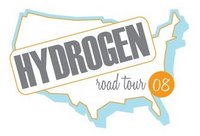Hydrogen Road Tour '08 Across USA With Electric-Hydrogen Fuel Cell Powered Car Rally Completed - VIDEO ENHANCED
 |
- SEE ALSO: Exclusive Video Interview With Catherine Dunwoody, Exec. Dir. of California Fuel Cell Partnership
- SEE ALSO: Press Pass Coverage 2008 Alternative Fuels and Vehicles Conference in Las Vegas
LOS ANGELES, Aug 24, 2008; Nine automakers celebrated the successful completion of a 13-day, cross-country road trip which served as the first significant U.S. test for fuel cell technology.
The auto manufacturers, the U.S. Department of Energy, the California Fuel Cell Partnership, National Hydrogen Association and U.S. Department of Transportation sponsored and participated in the event which started August 11 in Portland, Maine.
 |
But then one of the goals of the "Hydrogen Road Tour '08" was to demonstrate the need to build more fueling stations if the nascent technology is to develop, said Paul Brubaker, administrator for research and innovative technology for the U.S. Department of Transportation.
There are about 60 hydrogen stations in the United States, and only two are open to the public without prior arrangement. Participants successfully completing the tour included vehicles from BMW, Daimler, General Motors, Ford, Honda, Nissan, Hyundai, Toyota and Volkswagen.
Click PLAY to watch video story about the rally
The industry- and taxpayer-sponsored tour stopped in 31 cities in 18 states. Backers included two hydrogen producers, Air Products and Linde, which hope to become household names if hydrogen becomes a key to transportation.
Catherine Dunwoody, executive director of major tour supporter California Fuel Cell Partnership, said fueling stations will develop first in big cities such as Los Angeles, San Francisco, New York and Washington, D.C.
"There's a lot of curiosity about these vehicles," Dunwoody said near the finish line in Los Angeles on Saturday. "As we got to Allentown, Pennsylvania, people lined up and cheered."
The partnership she heads is based near California's capital, Sacramento, and funded by public and private funds.
"There's a hunger out there for clean, safe vehicles," Brubaker said. "The common refrain everywhere we went was 'Where do we get these cars.'"
For most people, the answer is nowhere soon. Honda Motor Co has begun leasing about 200 FXC Clarity fuel-cell autos in Southern California and General Motors Corp is testing about 100 fuel-cell Chevy Equinox SUVs on the road.
But those deployments, as well as the autos in the road tour, are experimental, since the technology is not ready for showrooms. Carmakers have spent billions on their development in hopes of capitalizing on a public desire to buy cleaner cars and a U.S. push to reduce its dependence on foreign oil.
The United States consumes about a quarter of the world's oil, and imports 70 percent of its crude. Cars and trucks consume 44 percent of oil used in the country and contribute about a fifth of the carbon dioxide emissions. CO2 makes up nearly 90 percent of U.S. greenhouse gas emissions.
Even in a best-case scenario, automakers will only sell about 2 million electric vehicles powered by hydrogen fuel cells by 2020, a study by the National Research Council found.
Linde and Air Products showed off their hydrogen-making machines to the public and at times refueled the autos.
The idea for the tour originated with Brubaker when he watched a Ken Burns documentary, "Horatio's Drive," at the same time that he was reading a biography of Dwight Eisenhower.
The Eisenhower biography mentioned the future president's cross-country trip as a young man, when he noticed long stretches without paved roads. When he was president in the 1950s, Eisenhower started the U.S. interstate highway system.
Burns documented the 1903 drive of Horatio Nelson Jackson who, on a bet, crossed the country in a 20-horsepower Winton car hoping to be the first to make the trip in an automobile. His journey from San Francisco to New York took 64 days.


